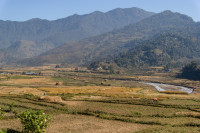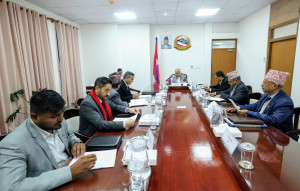Columns
Bracing for the new normal
Climate-induced extremes, once considered outliers, have now become our everyday reality.
Saroj Karki & Pawan Kumar Bhattarai
Floods and landslides have long been part of the country’s natural hazard landscape. Historically, such disasters were triggered by rare extreme weather events, often occurring once every few years or decades. Today, however, the monsoon season and disasters have become almost synonymous. What was once considered an occasional calamity is now an annual crisis: Devastating floods and landslides have emerged as the new norm. The growing impact of these disasters is not merely a result of climate variability, but also a reflection of increasing exposure due to unplanned development, weak policy enforcement and a general disregard for disaster risks.
Despite recent catastrophes that clearly signal what lies ahead, development planning, policy reforms, and infrastructure design in Nepal continue to rely on outdated approaches. These approaches fail to account for the heightened risks posed by a changing climate, human interventions and rapidly evolving land-use patterns.
Climate-induced extremes, once considered outliers, are now the new normal. Nowadays, even normal rainfall events significantly impact communities, infrastructures, agriculture, etc. This year seems no different. The Department of Hydrology and Meteorology (DHM) has forecasted above-average rainfall with an early onset of the monsoon, and the National Disaster Risk Reduction Management Authority (NDRRMA) has forecasted over 2 million people to be directly impacted by this year’s monsoon.
For a country already struggling with the aftermath of 2024’s catastrophic September rainfall that paralysed central Nepal, damaged critical infrastructure and claimed lives, this warning must serve as a call to action.
Climate extremes and their impact
Reports indicate that over 80 percent of the country’s population is at risk of natural hazards. The growing population in major cities, unplanned development and the rising frequency of disasters will further escalate the vulnerability of both people and infrastructure. The annual economic losses due to disasters amount to nearly 2 percent of Nepal’s GDP. Climate-induced disasters such as droughts, floods and landslides have triggered migration, exacerbating regional demographic disparities and socio-economic imbalances. This trend places additional pressure on urban infrastructure and public services in receiving areas, while leaving rural regions increasingly depopulated and vulnerable, thereby challenging equitable development and long-term resilience planning.
The financial burden of failing to act on disaster risk reduction is significantly higher than the investment required for proactive preventive measures. Last September’s floods and landslides alone inflicted losses of nearly Rs47 billion, predominantly in damage to public infrastructure. These losses were not solely due to natural forces but were largely amplified by policy gaps, including unplanned urbanisation, unregulated sand mining and poor enforcement of land use and environmental regulations. This underscores the urgent need for stronger governance, integrated risk-sensitive planning and enforcement mechanisms that prioritise long-term resilience over short-term gains.
Hydropower, highways, irrigation and water supply are among the key infrastructure sectors most severely affected by climate extremes. Frequent and increasingly severe disruptions such as highway blockages due to landslides, the washing away of roads and bridges by floods and sediment flows and the damage to hydropower, irrigation and water supply systems, highlight their vulnerability, especially as these infrastructures are often located in or near river corridors. With substantial and growing investment directed toward these sectors, there is an urgent need to enhance their resilience in the face of evolving hydroclimatic conditions and anthropogenic pressures.
Currently, most infrastructure designs rely on historical hydrological records, which have become increasingly inadequate for anticipating future risks, given the intensity and unpredictability of recent hydroclimatic events. Critical infrastructure must now be stress-tested against future climate scenarios, land-use and river morphology.
The agricultural sector’s vulnerability to the effects of the monsoon is heightened due to its reliance on rainfall. According to reports, the impact of climate change is projected to result in an escalation of economic losses arising from weather and climate-related events, with agricultural losses playing a substantial role in this context. The incidence of extreme events and consequent damage will have profound implications for sustainable development goals such as Zero Hunger and No Poverty in particular.
Tackling climate extremes
Can a country like Nepal deal with the unprecedented damage caused by extreme events? If the current circumstances continue, the answer is no. The financial limitation of a low-income country like ours cannot be overlooked, and we cannot always rely on foreign assistance to manage disasters. Climate finance and disaster risk reduction support from international partners is becoming increasingly uncertain due to global uncertainties and shifting geopolitics. This reality forces us to develop self-reliant strategies and action plans to tackle climate extremes and minimise future losses. To prevent economic, social, infrastructural, agricultural and food crises, we must recognise our present realities and plan accordingly.
The increasing frequency of extreme events and the consequent damage will severely impede the country’s goal of economic and social prosperity, as the need for reconstruction and rebuilding will inflict additional time and financial burden that are actually meant to be allocated to other sectors. Strengthening our ability to respond to climate extremes will help secure food systems, reduce poverty and build national self-reliance, especially as external aid becomes less predictable. Moreover, it is vital for protecting the lives and safety of people and communities who are most vulnerable to such events.
The National Policy on Disaster Risk Reduction, 2075, emphasises the importance of mainstreaming disaster risk reduction (DRR) across all sectors, including social, infrastructure, health, economic and environmental domains. However, the lack of clear implementation guidelines and sectoral urgency has hindered the effective translation of this policy into concrete actions on the ground. Nepal’s disaster risk reduction approach has traditionally been more response-oriented, with insufficient emphasis on proactive preparedness, a shift that could significantly reduce the costs of response and recovery.
Similarly, our mitigation strategies for disasters such as floods and landslides have remained largely unchanged for decades, despite their limited sustainability, effectiveness and relevance in the face of evolving challenges. We must critically reassess and modernise the conventional methods used for river training, landslide control and other disaster mitigation to ensure they are contextually appropriate and resilient to future risks. Local knowledge has often been overlooked when developing mitigation plans for floods, landslides and other disasters. Nature-based solutions, which offer sustainable and cost-effective alternatives, have not received the attention they deserve, especially considering the high investment demands of traditional structural measures.
Road ahead
The government alone cannot tackle the increasing disasters. So, there has to be a collaboration with NGOs, INGOs, universities, private institutions and community organisations on dealing with relevant components of disaster risk reduction such as awareness campaign, promoting local knowledge, research, etc. The current institutional structure, where the Ministry of Forests and Environment is assigned the leadership role in the climate change sector, lacks adequate coordination with key development infrastructure ministries (such as irrigation, energy and physical infrastructure). This may have contributed to the ambiguity in effectively integrating climate adaptation and disaster risk reduction into development planning. It is essential to establish a unified structure with clearly defined responsibilities that includes representation from all stakeholders involved in disaster risk reduction.
Dealing with disasters is not just about flood and landslide mitigation but should encompass planning and strategies for future risk across all development activities. Mainstreaming disaster risk reduction and extremities into the infrastructural development and management is urgent. Coordination between three tiers of government, with a focus on strengthening the capacity and role of local government, should be a top priority if the disaster impact is to be minimised. Planning for the new normal means integrating climate science, risk assessments and resilience thinking into our policies, budgets and infrastructure investments.
If we continue with the business-as-usual approach, we will face escalating losses. So it is imperative to embrace a transformative agenda that puts resilience and sustainability at the heart of development. This requires not just more investment, but smarter, better-targeted spending, coordination across sectors and the political will to enforce land use and environmental regulations.




 20.12°C Kathmandu
20.12°C Kathmandu
















